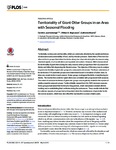Please use this identifier to cite or link to this item:
http://www.alice.cnptia.embrapa.br/alice/handle/doc/1017949Full metadata record
| DC Field | Value | Language |
|---|---|---|
| dc.contributor.author | LEUCHTENBERGER, C. | pt_BR |
| dc.contributor.author | MAGNUSSON, W. E. | pt_BR |
| dc.contributor.author | MOURAO, G. | pt_BR |
| dc.date.accessioned | 2015-06-17T11:11:11Z | pt_BR |
| dc.date.available | 2015-06-17T11:11:11Z | pt_BR |
| dc.date.created | 2015-06-17 | pt_BR |
| dc.date.issued | 2015 | pt_BR |
| dc.identifier.citation | Plos One, v.10, n.5, p.1-13, 2015. | pt_BR |
| dc.identifier.uri | http://www.alice.cnptia.embrapa.br/alice/handle/doc/1017949 | pt_BR |
| dc.description | Territoriality carries costs and benefits, which are commonly affected by the spatial and temporal abundance and predictability of food, and by intruder pressure. Giant otters (Pteronura brasiliensis) live in groups that defend territories along river channels during the dry season using chemical signals, loud vocalizations and agonistic encounters. However, little is known about the territoriality of giant otters during the rainy season, when groups leave their dry season territories and follow fish dispersing into flooded areas. The objective of this study was to analyze long-term territoriality of giant otter groups in a seasonal environment. The linear extensions of the territories of 10 giant otter groups were determined based on locations of active dens, latrines and scent marks in each season. Some groups overlapped the limits of neighboring territories. The total territory extent of giant otters was correlated with group size in both seasons. The extent of exclusive territories of giant otter groups was negatively related to the number of adults present in adjacent groups. Territory fidelity ranged from 0 to 100%between seasons. Some groupsmaintained their territory for long periods, which demanded constant effort in marking and re-establishing their territories during the wet season. These results indicate that the defense capacity of groups had an important role in the maintenance of giant otter territories across seasons, which may also affect the reproductive success of alpha pairs. | pt_BR |
| dc.language.iso | eng | eng |
| dc.rights | openAccess | eng |
| dc.subject | Ariranhas | pt_BR |
| dc.subject | Inundação sazonal | pt_BR |
| dc.title | Territoriality of giant otter groups in an area with seasonal flooding. | pt_BR |
| dc.type | Artigo de periódico | pt_BR |
| dc.date.updated | 2018-05-10T11:11:11Z | pt_BR |
| dc.subject.nalthesaurus | Pteronura brasiliensis | pt_BR |
| riaa.ainfo.id | 1017949 | pt_BR |
| riaa.ainfo.lastupdate | 2018-05-10 -03:00:00 | pt_BR |
| dc.identifier.doi | 10.1371/journal.pone.0126073 | pt_BR |
| dc.contributor.institution | CAROLINE LEUCHTENBERGER, INPA; WILLIAM E. MAGNUSSON, INPA; GUILHERME DE MIRANDA MOURAO, CPAP. | pt_BR |
| Appears in Collections: | Artigo em periódico indexado (CPAP)  | |
Files in This Item:
| File | Description | Size | Format | |
|---|---|---|---|---|
| journal.pone.giant.otter.territory1.pdf | 1,47 MB | Adobe PDF |  View/Open |









